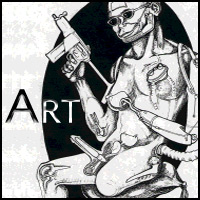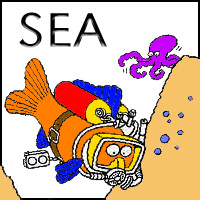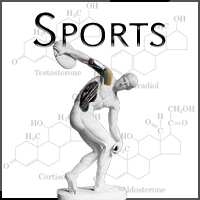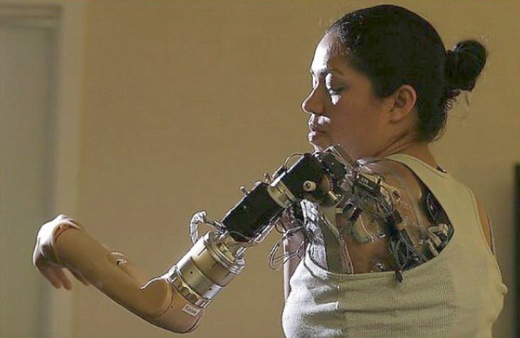
Medical CyborgizationRyan Loebs The use of foreign devices implanted into the body as a way of medical restoration, has been employed in medical science for decades. Medical research has had a heavy focus on restorative technology. Even though huge strides have been made in this area of medical science, there are still gaps in critical places, such as restoring full movement and senses to a paralyzed body. Medicine-based restorative implants are employed in every part of the body, from the brain all the way down to the feet. One of the most anticipated forms of medical cyborgization are brain-computer interfaces. A brain-computer interface is an electronic device that interfaces through wires and complex integrated circuit grids with the nervous system of the brain in order to gain access to certain functions of the brain. There are various applications for such a device, including paraplegic recovery, remote control over devices, or simply an extension of a perfectly functional body. In the early development of brain-computer interfaces, monkeys were used to help map out neural signals emitted when a particular action was performed. After isolating the desired signals, they were mapped and assigned to control robotic devices that imitated the original action, such as a robotic arm being raised (Artificial Limb). The only drawback to the interfaces created in the earlier development, is that they were open-loop interfaces. An open-loop interface means that the signal to perform the action is only sent, and no feedback is ever received for the action. In order for an interface to be truly restorative, the brain or nerve sending the initial signal must be able to get feedback from the action in some way. A possibility that stems from remote robotic control via brain-computer interface is the ability to control a device remotely, via the internet. Such a device would allow doctors to perform surgery on a patient in a remote location with the steadiness and precision of a machine, but with the knowledge and talent of a human. With the development of such an interface, many other possible applications arise. A cure for paralysis has been sought out for decades, and with the use of brain-computer interfaces, a severed connection between two neurons could be patched via wireless communication of two computer chips on the ends of the broken nerves (Fetz). This form of restoration would only theoretically work on a non-congenital form of paralysis, such as an injury resulting in a broken spine. This might be due to the fact that during development of the brain and motor skills, the child would never develop the knowledge that the limbs and muscles even existed in the body to begin with, and so would not have the ability to send the signals to move them. There is some thought as to the possibility of inserting a brain-computer interface into a newborn, paralyzed infant in order to replace the missing connections during the development of the brain. Brain-computer interfaces are not, however, always used for a restorative purpose. A more enhancement-oriented application for brain-computer interfaces is the use as a sort of joystick for computers. Such devices implement a non-invasive method of detecting brain waves, known as electroencephalography, which is more commonly known EEG. This method reads electrical impulses emitted by the brain during neuron interaction (Brain Controlled). This has been put to use, as a preliminary proof-of-concept, in the widely used multiplayer game called Second Life. In this application the user wearing the interface must think about moving their legs as if to move forward. This thought is mapped to the game in the action of moving the character forward. If the user wishes to turn their character side-to-side, they must think about raising the arm in which they want to turn. Right arm for turning right, and the left arm for turning left (Brain-Computer). With such strides in non-invasive brain-computer interface devices the concept of virtual reality grows closer. An Australian hardware company has managed to bring virtual reality yet another step closer, by manufacturing a brain-computer interface for consumers. This device is designed to interface with game software in order to make game play more intuitive for the user (Brain-Controlled). Although this is the intended target, it is not limited to just entertainment uses. It could, theoretically, be used in the same way voice-recognition software is used today. Software that would type as you thought, would far surpass the speed and correctness of voice recognition software. A form of medical implantation that has been in practice for some time is the creation of artificial organs. Throughout the years, organ failure has lead to the deaths of many patients due to the lack of a compatible organ donor. Because of this, the drive towards creating artificial organs to take the place of a biological organ has lead researchers to create various, life saving devices. One such device is an artificial lung. This device, although it is not intended for long term use, has enabled patients with damaged lungs to survive the wait for a donor lung. An artificial lung replaces the function of oxygenating the blood passing through the lungs. The method in which an artificial lung oxygenates the blood as it passes through it, is with a membrane oxygenator. The membrane separates the used carbon dioxide from the blood and allows oxygen to permeate into the cells. The carbon dioxide exits through one valve as oxygen enters through the other (Membrane). The blood enters the device through the heart's regular pumping to prevent damage to the blood cells. Another, more prevalent device is the artificial heart. This devices is used to pump blood throughout the body, and completely replace a biological heart. The first completely self-reliant heart transplant was performed in 2001 in Kentucky (Artificial Heart). In 2006, the FDA fully approved the artificial implant as a 'Humanitarian Use Device' (Valetkevitch). Prior to this device, artificial heart transplants were used in the temporary fashion, similar to the artificial lung, in that it was used solely to keep the patient alive while a donor heart was searched for. A major drawback to mechanical hearts is the inability to change the heart rate. This prevents the patient from participating in any exercise, or strenuous activities that require more blood flow to keep the muscles and organs going. An alternative to a fully mechanical heart transplant, is a ventricular assist device. These devices will supplement the heart and take over failing functionality instead of replacing it entirely. This method resolves the issue of a constant heart rate with a fully mechanical heart (Ventricular). The heart is still muscle-controlled and can receive signals from the brain, but is aided by the devices. An implant that falls under a few categories is the brain pacemaker. This brain-computer interface acts in a similar fashion to the pacemaker more commonly attached to the heart. The brain pacemaker acts to quell “electrical storms” in the brain of a patient suffering from a disease such as Parkinson's disease, epilepsy, or even depression (Brain pacemaker). The device is implanted directly into the brain with wire leads connected to the part of the brain that is being regulated. The regulator is placed down below the patient's clavicle with wires running up the patient's neck to the leads (Brain pacemaker). The controller is placed under the clavicle to ease the process of replacing batteries, adjusting the device, and to prevent any potential damage to the brain or skull after the leads have been set. The most common and wide-spread medical implants are prosthetic limbs. Prosthetic limbs, of all types, are the least intrusive of all medical implants. The most sophisticated prosthetics are artificial arms. Artificial arms restore functionality to limbs that were either traumatically or congenitally destroyed. There are multiple types of prosthetic arms that can be attached to provide varying levels of functionality. The most basic of arms is a simple claw that attaches to muscles and tendons in the biological arm to allow the patient to open and close the claw arms. This provides the basic movement to simulate a very crude hand. On the other side of the spectrum, there are fully mechanical prosthetic arms that provide a very sophisticated replacement for the forearm and hand. These prosthetics have highly sophisticated technologies that react to nerve and muscle movements to provide as life-like a reaction as possible. Biosensors are used to detect the signals sent from the patient's nervous system, or muscles to be translated into movements in the new arm.
A much more basic prosthetic is the artificial leg. Artificial legs can vary from a simple pole, grafted to an amputated limb, to a hinged knee replacement. Even though these technologies have been employed for decades, new robotic replacements are under development to find a way to fully replace the amputated limbs. A technique called Targeted Muscle Reinnervation remaps the impulses sent to different muscle groups in the body. If the patient wearing the robotic arm wanted to move their thumb, the signal would be translated into a muscle movement in the pectorals, which would provide the signal to the robotic arm to flex the thumb (Artificial limb). In the opposite direction, a stimulus occurring on the robotic arm would return a signal to the muscle group used, such as the pectorals, and would be translated as if it were coming from the missing thumb. Although restoration to motor skills through implants and prosthetics are necessary, so are the aesthetic implants employed in medical science. This can range from a skin graft for a burn victim to a breast implant for a breast cancer victim. In the case of a breast implant, the purpose is aesthetic to restore the natural look to the patient who might have had their breast tissue fully removed to prevent the spread of cancer, but also helps to restore the patient's self-confidence about their self-image. Any other form of breast implants are purely in vain and are in no way restorative. Aesthetic implants that also restore functionality to the patient are bone grafts. A bone graft adheres new bone to a part of the body that has either suffered damage or never developed the mass to begin with (Bone). This is used most during dental implants, where the patient's skull never grew the necessary bone to anchor the teeth, and so teeth never grew in. In order to use the right kind of bone for the grafting process, bone is usually harvested from a cadaver to attach to the patient. After the bone has been grafted, a mechanical anchor is placed into the skull to provide an easy screw hole for the final artificial tooth (Dental). As well as providing a more pleasing aesthetic restoration to the patient, a dental implant can restore chewing functionality. Another form of grafting includes the grafting of skin onto other parts of the body. A skin graft takes skin from another part of the patient's body, such as the buttocks, and uses it to replace damaged or lost skin on another part of the body. One such example is for a burn victim. When the victim starts to lose skin on their arms or face it can be replaced with healthy skin from either a cadaver or another region of the body. This implantation provides both an aesthetic restoration, as well as the protective functionality of the skin. As technology improves so does the understanding of the human nervous system, artificial replacements of human organs and limbs bring us closer and closer to eliminating the problems of losing limbs and body parts. With technologies already in development, improving the processes and technologies used in artificial body parts, the ability to have a fully-functional, fully sensing robotic limb is not far off. The ability to replace a human arm with a robotic one that moves all five fingers with a decent amount of speed, arms and legs is even closer. As medical science provides surrogate replacements for human organs, the need for biological transplants becomes unnecessary altogether. Works Cited
Image credit:http://www.cracked.com/funny-6181-cyborgs/ http://truthmafia.com/archives/5994 |











